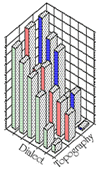
Excerpt from J.K. Chambers, "The Canada-U.S. border as a vanishing isogloss: the evidence of chesterfield." Journal of English Linguistics 23 (1995): 156-66.
The most comprehensive evidence of the decline [of the Canadianism chesterfield] comes from the survey called Dialect Topography of the Golden Horseshoe (Chambers 1992). This postal survey, undertaken in the winter of 1991-92, elicited linguistic responses from a large representative sample in Canada's most populous region, the so-called Golden Horseshoe around the western tip of Lake Ontario. The region takes in the conurbations of Oshawa, Scarborough, Toronto, Mississauga, Oakville, Burlington, Hamilton, St. Catharines, Welland and Niagara Falls. Over five million people, more than one-sixth of Canada's population, live in this 250km strip.
The 80 American respondents on the U.S. side of Niagara answered the question about the name they used for the long upholstered seat that holds three or four people in a straightforward way: 81.2% said couch, another 12.5% said sofa, 2.5% said davenport (two people) and coach (two others), and one said love seat. The Canadians, by contrast, provided eleven terms. Moreover, whereas none of the Americans responded with more than one term, 70 of the 935 Canadians did.
|
|
|
|
|
|
|
|
|
|
|
|
||
|
|
|
|
|
|
|
|
|
|
|
|
|
|
|
|
|
|
|
|
|
|
|
|
|
|
|
|
|
|
|
|
|
|
|
|
|
|
|
|
|
|
|
|
|
|
|
|
|
|
|
|
|
|
|
|
|
|
|
|
|
|
|
|
|
|
|
|
|
|
|
|
|
|
|
|
|
|
|
|
|
|
|
|
|
|
|
|
|
|
|
|
|
|
|
|
|
|
|
|
|
|
|
|
|
|
|
|
|
|
|
|
Table 1 divides the Canadian respondents into age groups and lists the percentage of each group (with the raw score in parentheses) for each term. Only three of the terms,couch, chesterfield, and sofa,occur in all age groups. The other terms,davenport, settee, love seat, love couch, lounge, divan, bank and chair have very little currency.
An obvious observation about Table 1 is that the percentages decline steadily as you scan the first column, couch, from top to bottom, that is, from the youngest to the oldest, and conversely the percentages increase as you scan the second column, chesterfield, from top to bottom. Sofa, in the third column, shows a slight and inexplicable currency among the middle groups, from ages 30 to 59, suggesting that it briefly, but unsuccessfully, competed with couch when chesterfield was losing ground. Among the other terms, settee occurs widely enough to give it status as a variant in the Golden Horseshoe. The others may well be family terms (bank from an 80-year-old woman whose parents were Dutch), or nonce terms (love couch, lounge), or mistakes (chair from a 20-year-old university student from St. Catharines).
The rapid replacement of the indigenous chesterfield by the American standard term couch is graphically evident in Figure 1, which plots the use of these two terms by the age groups, from the oldest to the youngest.

The chronology of the decline of chesterfield and the rise of couch can be inferred from the apparent-time display in Figure 1. Chesterfield remains the most frequent term for people 50 and over. In the 1930s, when the 50-59 year- olds were born, it was presumably nearly unanimous. In the 1950s, when the 30-39-year-olds were born, it was being supplanted, and in the 1970s, when the youngest group represented here was born, it was coming to be associated with the speech of older people. They consider it to be 'quaint', and it is sometimes unknown by younger people.
 |
 |